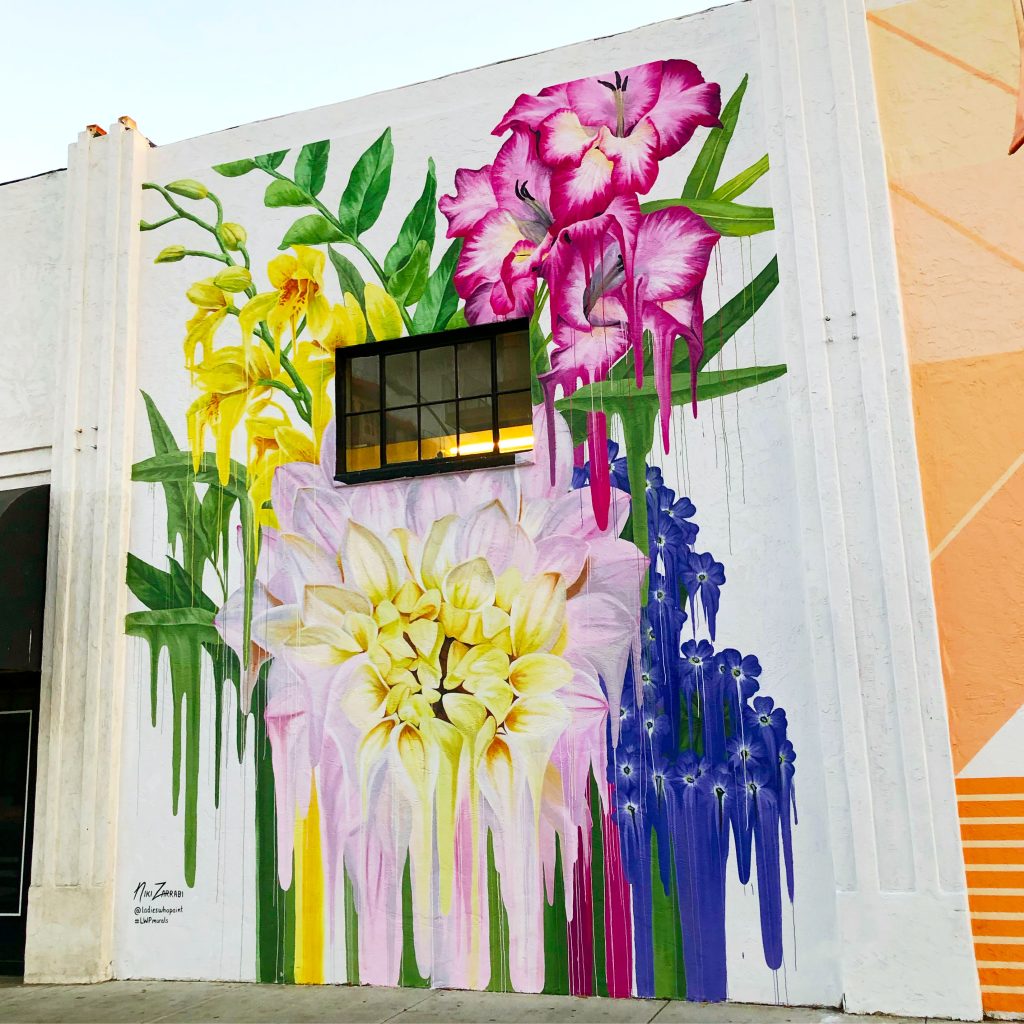
Niki Zarrabi created this mural in 2019 for the Ladies Who Paint event in San Diego.
She is currently showing work at ABV Gallery in Atlanta for their Spring Group Exhibition, REFRESH, on view until 3/23/24.

Niki Zarrabi created this mural in 2019 for the Ladies Who Paint event in San Diego.
She is currently showing work at ABV Gallery in Atlanta for their Spring Group Exhibition, REFRESH, on view until 3/23/24.
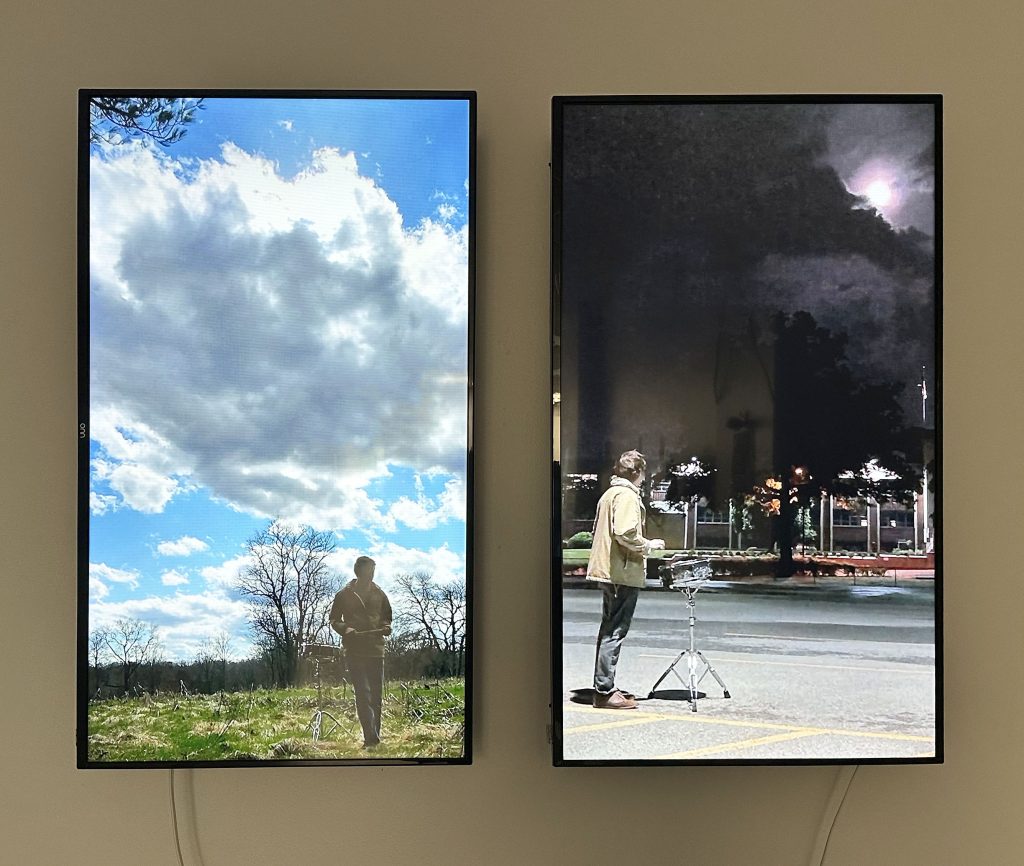
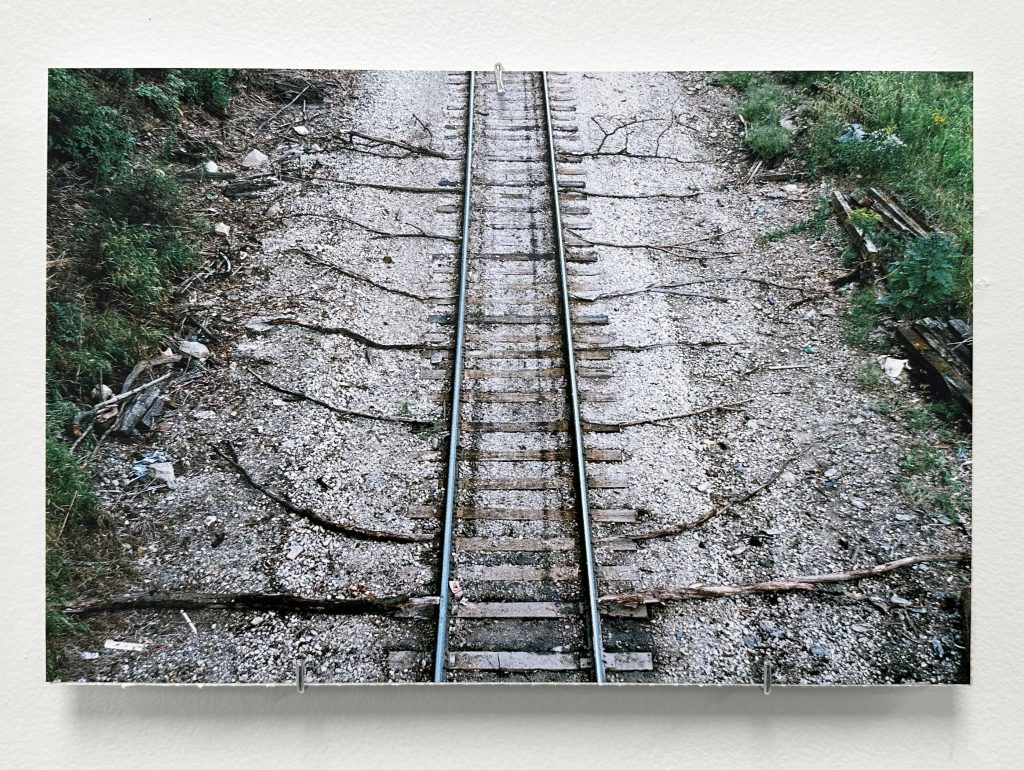
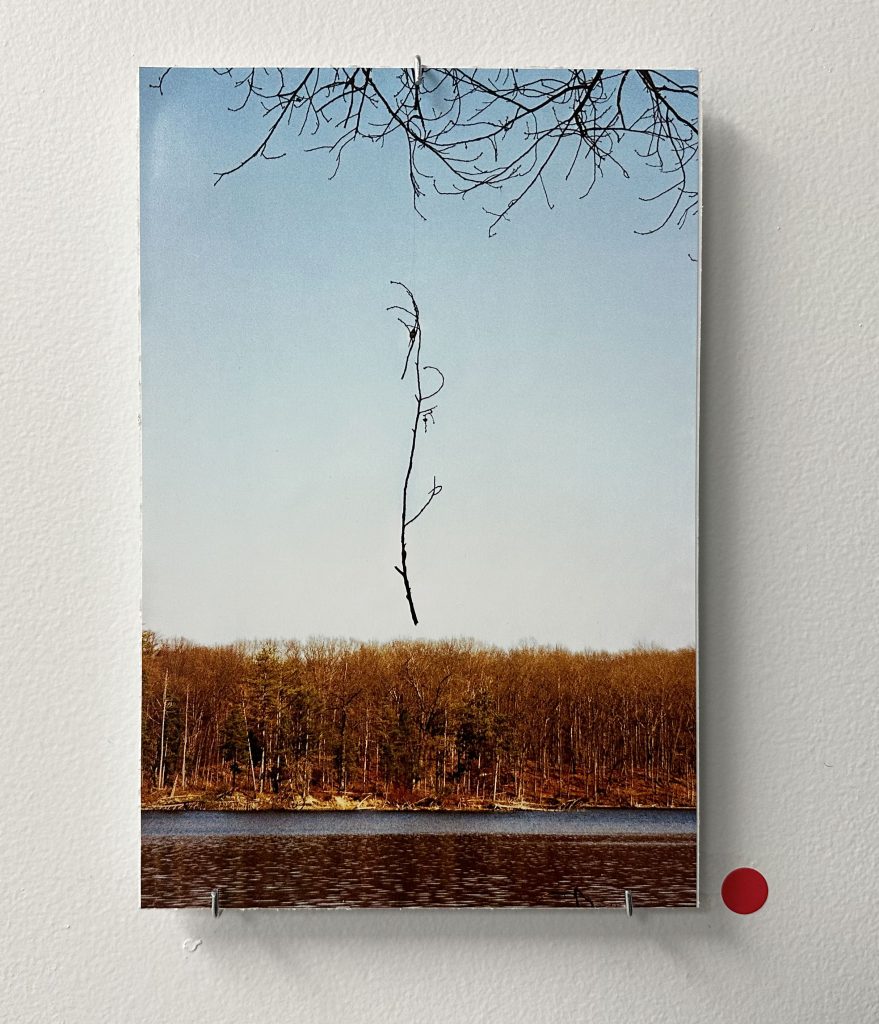


Akron Soul Train supports local artists through a residency program, exhibitions, and a shop in the front of the gallery which sells their work. Currently the gallery is showing work by Matthew Kurtz (work seen above) and Thomas Smith (work pictured below). Both artists are approaching the environment in different and interesting ways. Several of Kurz’s video pieces are focused on his upcoming performance for the solar eclipse. His photographs, for which he’s created additions to scenes he finds, are charming- as is his sculpture- a piano that moves his natural additions when played.
From the gallery-
Performance artist Matthew B. Kurtz presents Drumroll for a Total Eclipse: A Preliminary Exhibition, a prelude to his upcoming live performance with this year’s solar eclipse. Kurtz’s work fuses place, nature, sound, rhythm, and movement to question the mystery of existence. With humor, curiosity, and in tandem with his surroundings, Drumroll explores the process of trying to understand wonder.
For his upcoming performance on April 8, 2024, Kurtz will invite an audience to celebrate the total eclipse. Collaborating with the cosmos, he will perform a drumroll before “totality” passes over Northeast Ohio and creates the natural phenomenon known as “the blackout.”
“When I engage with a site for an art piece, I consider its history, recontextualize its objects, and insert my identity through intuitive gestures. I was raised to believe that humans are supposed to connect the lines between their innate feelings and the unknown. Making art is [my] attempt to reclaim this existential directive. These experiences are documented so outside viewers can participate in my examination of ambiguities, systems, and the sublime.” — Matthew B. Kurtz
Kurtz is also a musician. Check out his Instagram and Bandcamp to listen to his 2021 album 107.
For Thomas Smith’s sculptures he creates natural environments within man-made structures and uses the results as a commentary on the growth and sustainability of suburban development.
From the gallery-
In SUBARIUM II reprise, Thomas Smith combines materials from big box stores with contained terrariums to generate a sense of security and quality. However, upon second look, the viewer may see past the façade of what may look safe to what is substandard. Perhaps it is even denying growth and positive change. Smith’s sculptures dare to ask questions about survival, public image, and the landscape of today.
“Akin to an ecosystem enclosed in a terrarium, my sculptures depict a vibrant but, ultimately, unsustainable artificial environment. As plants within the terrarium grow, competition for space intensifies, turning the once-comfortable space into a struggle for survival. The metaphor extends to suburban America, where curated living conditions prioritize aesthetics over functionality, reflecting an impermanent American Dream.”
— Thomas Smith

Both of these exhibitions close 3/23/24.
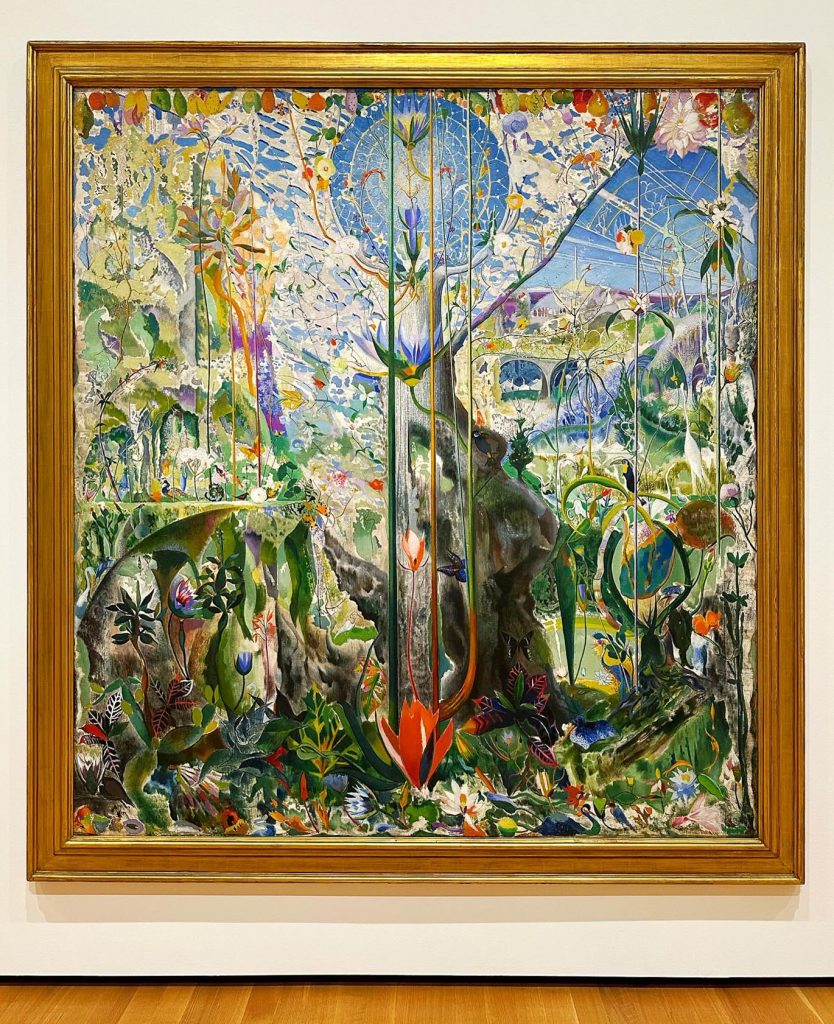
On view as part of the permanent collection at Akron Art Museum is Joseph Stella’s oil painting, Tree of My Life, from 1919.
From the museum about the work-
Joseph Stella described his inspiration for Tree of My Life as an epiphany: “A new light broke over me. I found myself in the midst of a joyous singing and delicious scent … of birds and flowers ready to celebrate the baptism of my new art.” Throughout the painting, forms and colors are infused with symbolic significance. The gnarled tree trunk represents the weathering effect of life’s temptations, while red lilies, blue patches of sky, and white blossoms symbolize lifeblood, divine protection, and spiritual ascendance. Stella, who maintained connections to his native Italy while living in America, combined this dense visual poetry with elements of adventurous European styles. Tree of My Life thus presents a distinctive new vision, marking an important moment in the course of Stella’s career and in the progress of American modern art.
Happy first day of spring! (in the Northern Hemisphere)
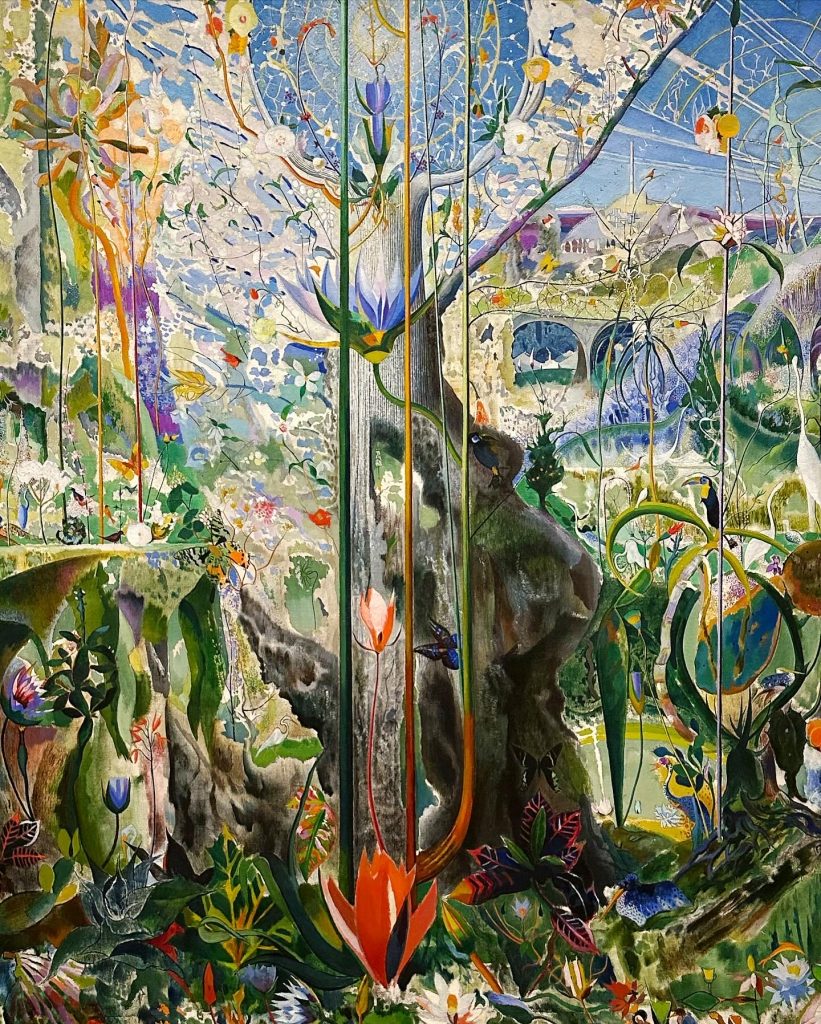


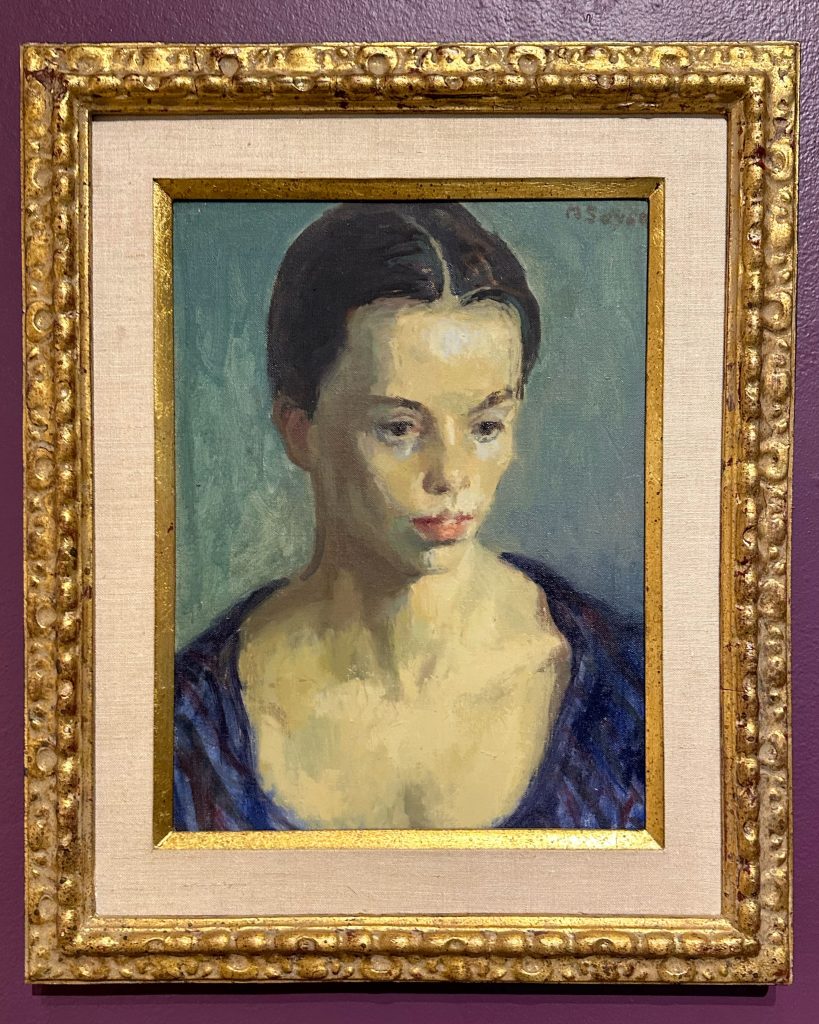
Moses Soyer’s oil painting, Young Girl, is one of the works on view in A New Deal: Artists of the WPA from the CMA Collection at Canton Museum of Art. The exhibition is a reminder of one of the best social programs ever created by the US government and the positive impact it had on the country during one of its hardest periods.
From the museum about the exhibition-
Against the backdrop of severe economic strife caused by the Stock Market Crash of 1929, President Franklin Roosevelt created the Works Progress Administration (WPA), which put roughly 8.5 million Americans, including more than 173,000 men and women in Ohio, to work building schools, hospitals, roads and more. Within the WPA was The Federal Art Project (FAP) which provided employment for artists to create art for municipal buildings and public spaces. The FAP had a non-discrimination clause that meant it attracted and hired artists of color and women, who previously received little attention in the art world. The only guidance the government offered about subject matter was to depict the “American scene” and stipulated no nudity or political issues. The goal was for artists to help the United States develop its own distinct American style of art, especially as artists in other parts of the world were forbidden freedom of expression and ordered to create artworks that projected the beliefs of their governments.
Though the WPA artists in the United States shared the common goal of capturing life in all its variety and promoting national pride, they each had different approaches, and many modified their typical subject matter to fit whatever project they were assigned. The arts before and after the New Deal relied on private patronage and the philanthropy of wealthy and elite institutions: galleries, museums, dealers. But during the WPA, art wasn’t a luxury good, it was seen as an essential part of our democracy. Artists were seen as professional workers who were making important and significant contributions to American life. The artworks made under the WPA became the collection of the American people and were put in public collections – hospitals, schools, post offices, housing projects, etc. – ensuring they were part of communities. The arts were seen as an important part of a democratic society and the American way of life, with a richness of experience and accessibility to culture.
While artists were offered opportunities through the WPA, they were far from immune to the distress caused by the Depression, and many still struggled to make a living. Will Barnet detailed a bleak scene he came across, saying:
“It was like a war going on. There were bread lines and men lined around three, four, five, six blocks waiting to get a bowl of soup. It was an extraordinary situation. And one felt this terrible dark cloud over the whole city.”
Moses Soyer also described the hardships artists experienced, saying,
“Depression–who can describe the hopelessness that its victims knew? Perhaps no one better than the artist taking his work to show the galleries. They were at a standstill. The misery of the artist was acute.”
The FAP supported the creation of thousands of works of art, including more than 2,500 murals that can still be seen in public buildings around the country. The FAP also supported art education and outreach efforts, including traveling exhibitions and art education programs for children. The WPA and FAP had a significant impact on the American art scene, and many of the artists who participated in the program went on to become important figures in the art world.
A New Deal: Artists of the WPA from the CMA Collection highlights the lives of artists from our Permanent Collection who worked for the WPA, and in doing so, fostered resilience for a struggling nation. You will learn about the projects they worked on, the subjects they were interested in, and how their own lives were affected by the Depression. Each of these artists helped to foster the nation’s spirit and prove that even in the darkest of times, art serves as a uniting force to collectively lead people into a brighter future.
And about Moses Soyer and his painting from the museum-
The Depression set the mood for most of Soyer’s art expression, and his portraits of people seem to be preoccupied with a sad secret. His portraits were often of solitary fi gures, using professional models or his friends, capturing in these paintings the spirit of his sitters, their dreams or disillusionment. He is best known for his introspective fi gure paintings of weary, melancholy women in muted colors, matching the mood of his sitters with the pigment in his paint. He was inspired by artist Edgar Degas, who used color expressively.
On the museum’s website you can find both the artwork on display for the exhibition and also a gallery of the museum’s entire collection organized into several categories.
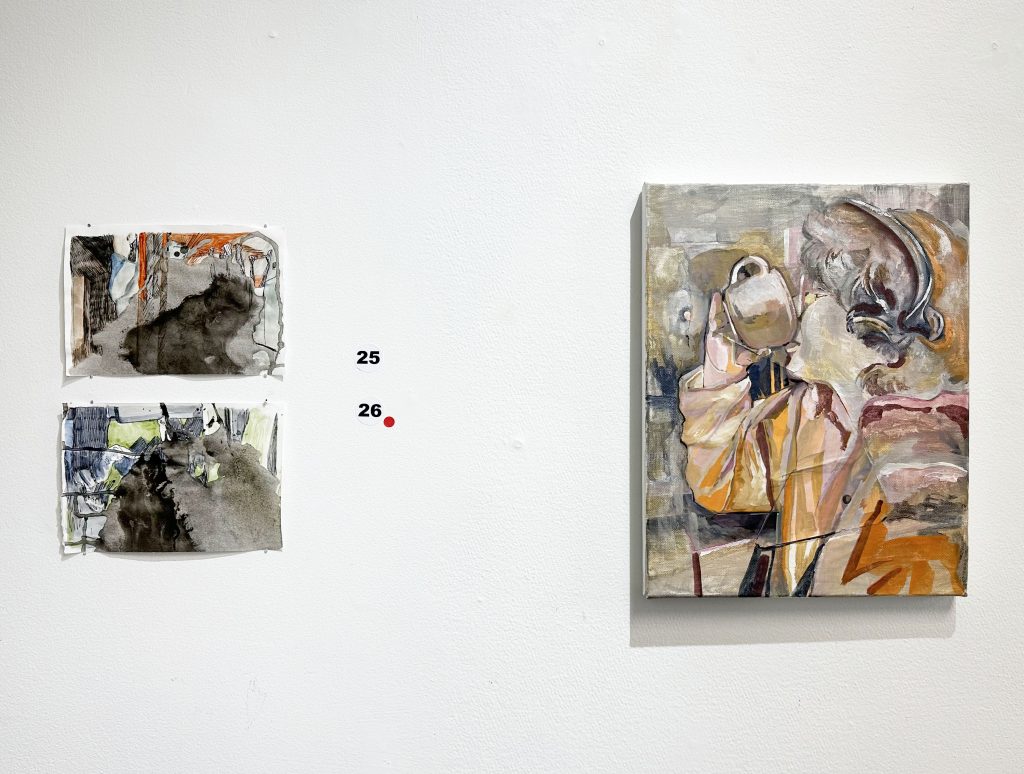
Watercolor paintings by Katherine Strobel

There is A LOT of work currently on view at Summit Artspace for their Winter Exhibitions (see the previous two posts) and it is worth mentioning these shows as well.
In the Welcome Gallery are watercolor paintings (seen above) by Katherine Strobel, for her exhibition, Bad Nostalgia.
Her statement about the work-
People forget to take pictures of things that don’t matter because it’s impossible to photograph qualities such as the feeling of an inside joke, the sound of an exhale through the nose, or dirty silverware that must be returned to the kitchen and replaced. These things act as set, pieces for what make up the rest of our lives. This series is a catalog of work that focuses on memory and candidness of a scene or subject. The people pictured are painted from life or candid photographs which are then emphasized from a naive image to something more. When an image is exaggerated with new colors and shapes it serves to make the mundane more desirable. The paintings are watercolors with a textured surface; the texture creates a sense of play with paper elements. In my work watercolor is often indicative of memory because of its ephemeral quality and transparent layers. This is because of how impossible it is to clarify every element that makes up a color when the layers are all compressed and viewed as a complete state.
Below are works from FRESH, an annual exhibition of local artists juried by Pita Brooks, Executive Director of Akron Soul Train. The website has all of the artists included and their statements and bios- definitely worth taking a look at what is being created in the area.
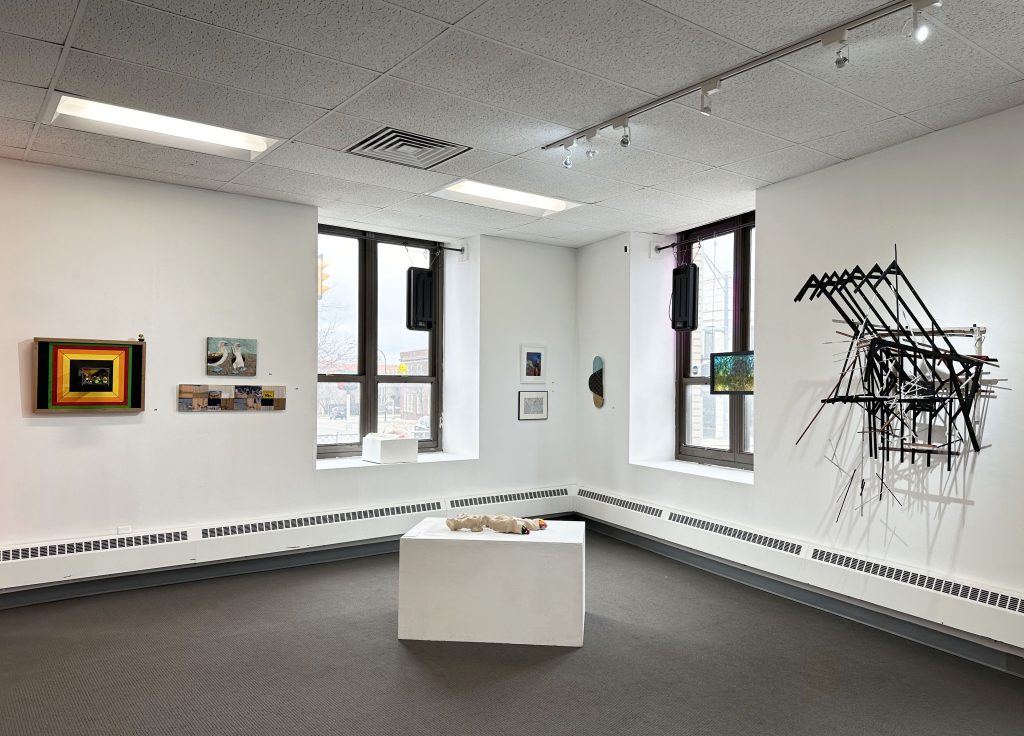
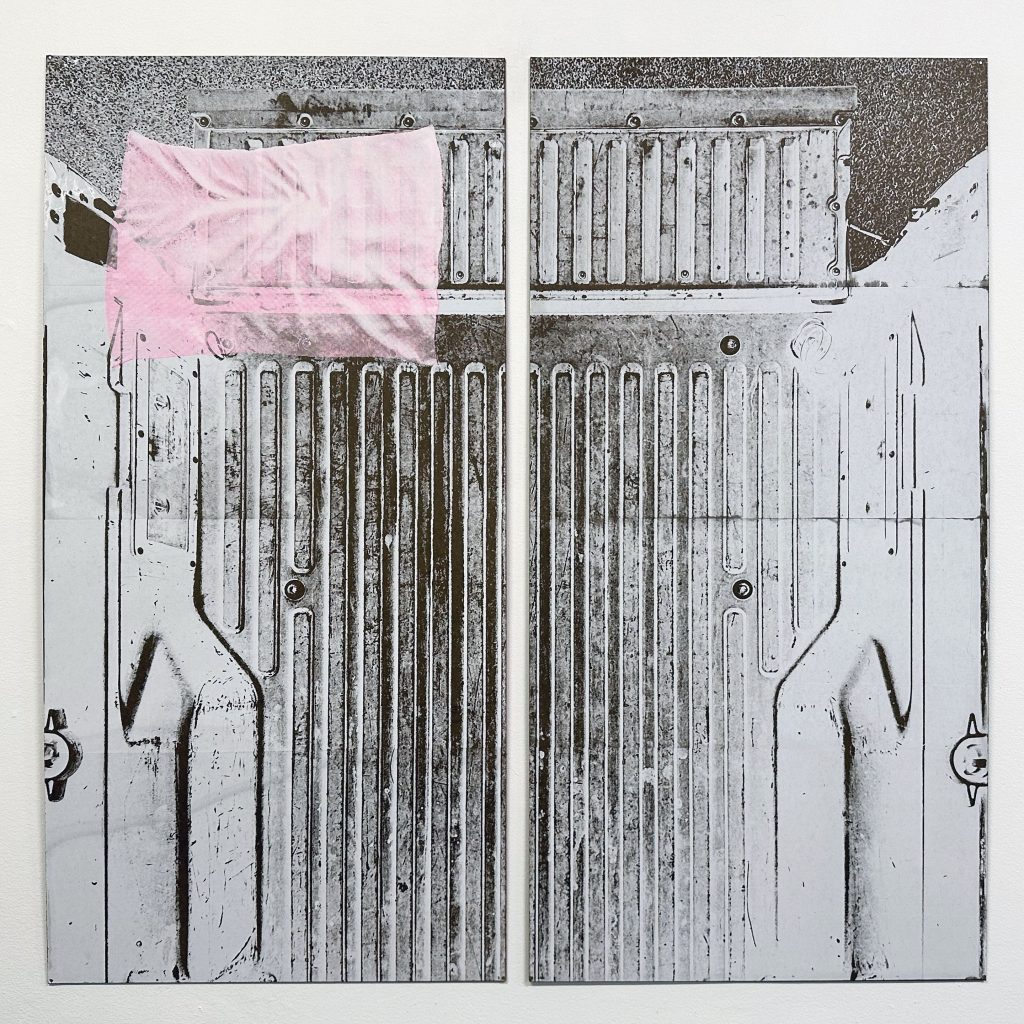
Michelle Eisen, “I’ve Made My Bed”, Silkscreen on hardboard

Steven Mastroianni “Fathomable Series #24”, Unique cameraless photogram, silver gelatin print
Finally, on view throughout the building are works by local students, teachers, and school leaders for Taking Care of Our House: Communities Coming Together and Making a Difference. The exhibition is made with the organization Art Resistance Through Change (ART-C). The works pictured below are a few of the sculptures created that included the personal narratives of the artists.
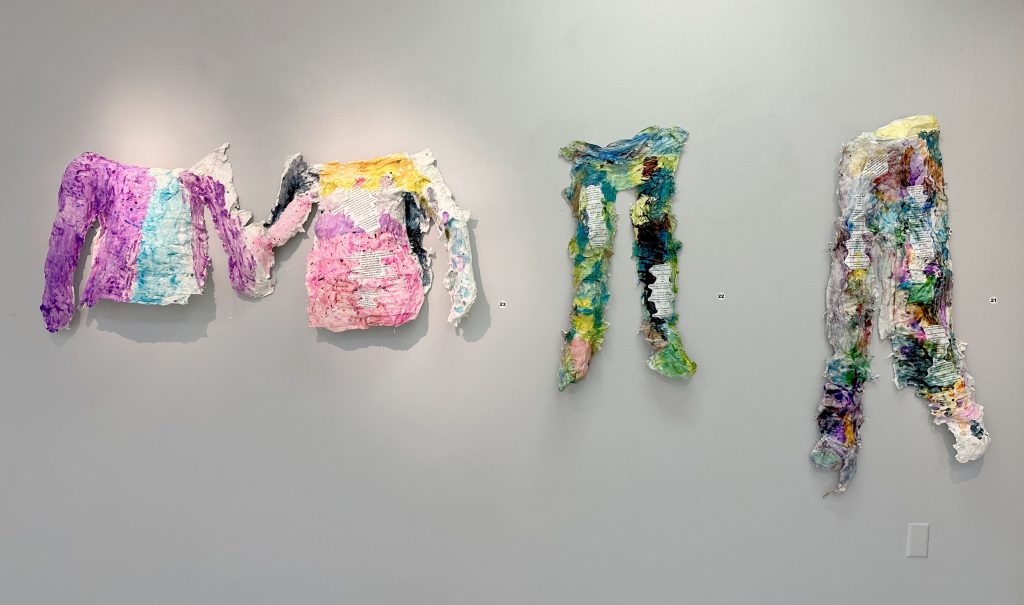
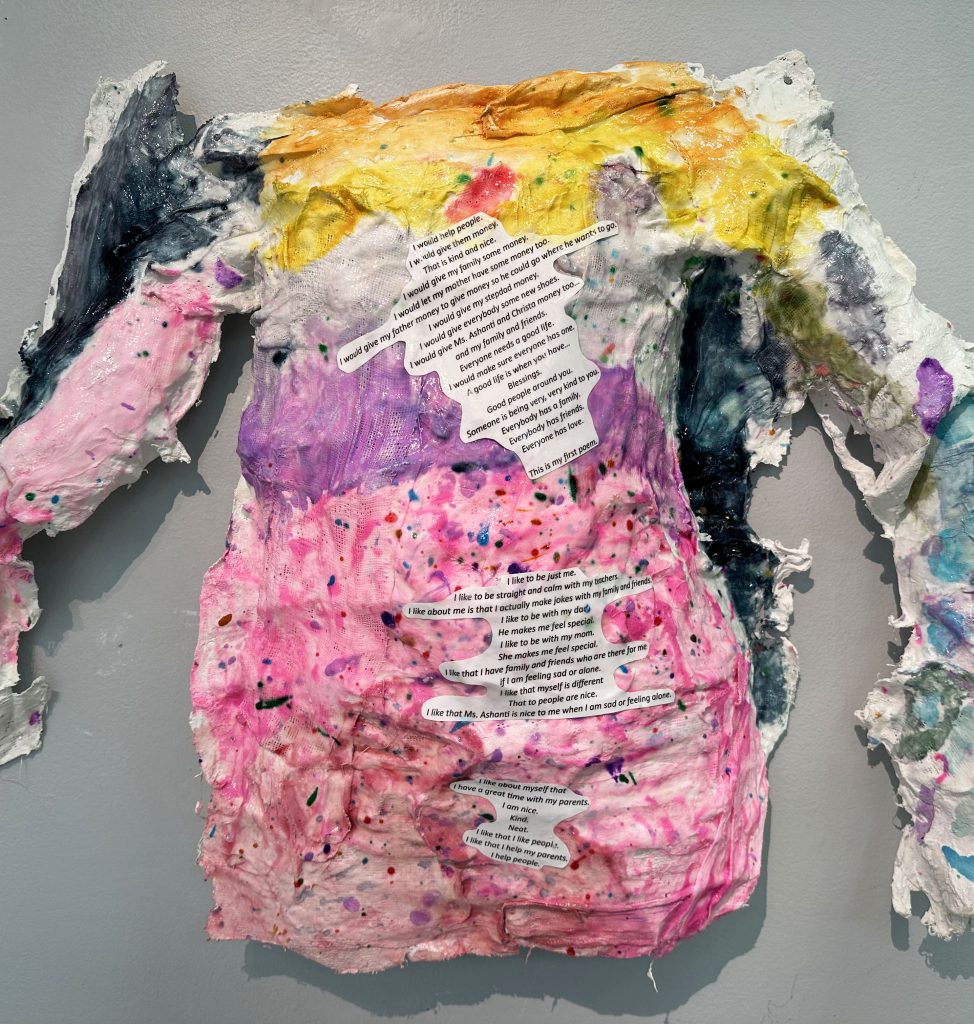
It’s worth mentioning that along with these exhibitions there are artists studios and galleries also in the building and worth checking out. Summit Artspace is open Fridays 12-7pm and Saturdays 11am-5pm.

Stephen Tornero “Don’t Tell Me” Hand dyed wool, acrylic rods

Chad Troyer “Crashing Waves” (bottom) and “Calming Shores” (top) Jacquard-woven, gradating waffle weave; Cotton, linen, rayon, silk, birch

Jen P. Harris “Oscillator” (left) and “Sphinx” (right) Hand-woven cotton, canvas, gesso, and thread on wood stretcher bars//Hand-woven cotton, canvas, thread, and acrylic paint on wood stretcher bars

Trey D. Gehring, “Stacked” Woven cotton yarn, crocheted acrylic yarn, fabric paint

Etta Sandry “Pivot: Moi-même” and “Pivot: Big Squish”, Cotton and cottolin, handwoven on Jacquard loom//Cotton and wool, handwoven on Jacquard loom
There are some incredible pieces in Waffle Weave Invitational, one of the current exhibitions at Summit Artspace. A few selections are pictured, but head to the gallery’s website to see all of the work on view.
From curator Stephen Tornero (who also has work in the show)-
This show was conceived as an idea to focus on a specific structural variable of a textile, and see how many different variations artists, artisans, and craftspeople would be able to produce. While researching the development of weaving technology, a loom with the capability to create complex structures was developed around 600 CE simultaneously in different cultures. This structure could have been produced by these looms, but also could have been designed much earlier by hand-manipulation of threads by the weaver. The waffle structure is so unique in its ability to transform a textile- seemingly a two dimensional surface- into a three dimensional object that has depth as shown by many repeated square pyramidal cells. Historically, this structure was used to create a textile that would hold water in its cells for cleaning or drying, or to help insulate the body with tiny pockets of air. This structure can be modified by changing the color of the threads with which it is woven, the fiber content of those threads, or even by expanding the amount of threads used in a cell, expanding the scale.
Statements from the artists about the work pictured above (from the Summit Artspace website)-
Stephen Tornero– Don’t Tell Me– “This piece is part of a continuing study of material, color, and structure in textiles. I have been mesmerized with the “waffle weave” structure and its ability to create large, three dimensional pockets of space. This pieces experiments with the combination of the flexible, fibrous wool yarns with the rigid neon acrylic rods. These two materials are combined in a large textile in order to explore the effects that this unique weaving structure will have on these materials. This use these two opposing materials in the piece creates a dialogue between the traditional usefulness of this wool weaving and its display on the wall as a work of art.”
Chad Troyer– Crashing Waves and Calming Shores– “The gradating structure allows for the weft to float acrost the surface of the weaving for varying lengths, from half an inch to nearly the whole width. The warp is allowed to float for varying lengths, but not nearly as long as the weft. After it was taken off the loom, the weaving was stretched. Parts of it were pulled, and others were left loose, allowing the floats to be accented by the folding and tautness of the cloth. The two pieces are the same piece of cloth cut apart, however they both display a different state of being: turbulent & calm.”
Jen P. Harris– Oscillator and Sphinx– “These small weaving-painting hybrids are part of an ongoing, experimental body of work in which I am developing a heterogeneous formal language that both honors and questions histories and conventions of painting and weaving.”
Trey D. Gehring– Stacked– “Stacked follows a line of investigation by the artist into a poststructuralist analysis of language as a system of symbols that lack meaning beyond context. The piece melds the namesake with the woven structure itself creating a hyper-literal interpretation of the exhibition’s theme. However, an understanding of the theoretical underpinning is unnecessary and secondary to the enjoyment of the whimsical and humorous nature of the work.”
Etta Sandry– Pivot: Moi-même and Pivot: Big Squish- “My woven work focuses on samples that explore dimensionality in woven cloth using techniques such as multi-layer weaving, pleating, and woven structures that are elastic, self-shaping, and otherwise transformative, like the pocketed cells of waffle weave. This work creates a series of translations between the flat draft and the materiality of the cloth. Weaving is a technically binary structure: a warp thread can be either raised or lowered. When drafted, woven structure is drawn as a flat grid. Woven in multiple layers, cords, and pleats, weaving maintains its inherent binary nature but takes on a new physical dimensionality. Between the flat draft and the woven cloth, there is an unknowable material transformation that reflects the nuance, radical variation, and possibility that emerges from a seemingly set and limited system. In these works, this variation is expressed through two large waffle weave samples that test the limits of the waffle structure. Each piece weaves the same design of increasingly large waffle cells. Moi-même presents a balanced the waffle weave in which warp and weft threads of a similar weight and color draw out a subtle loosening of the structure as the size of the cells increase. In The Big Squish, the waffle structure is boldly packed, extended and distorted by colorful wool wefts.”
This exhibition closes 3/16/24.






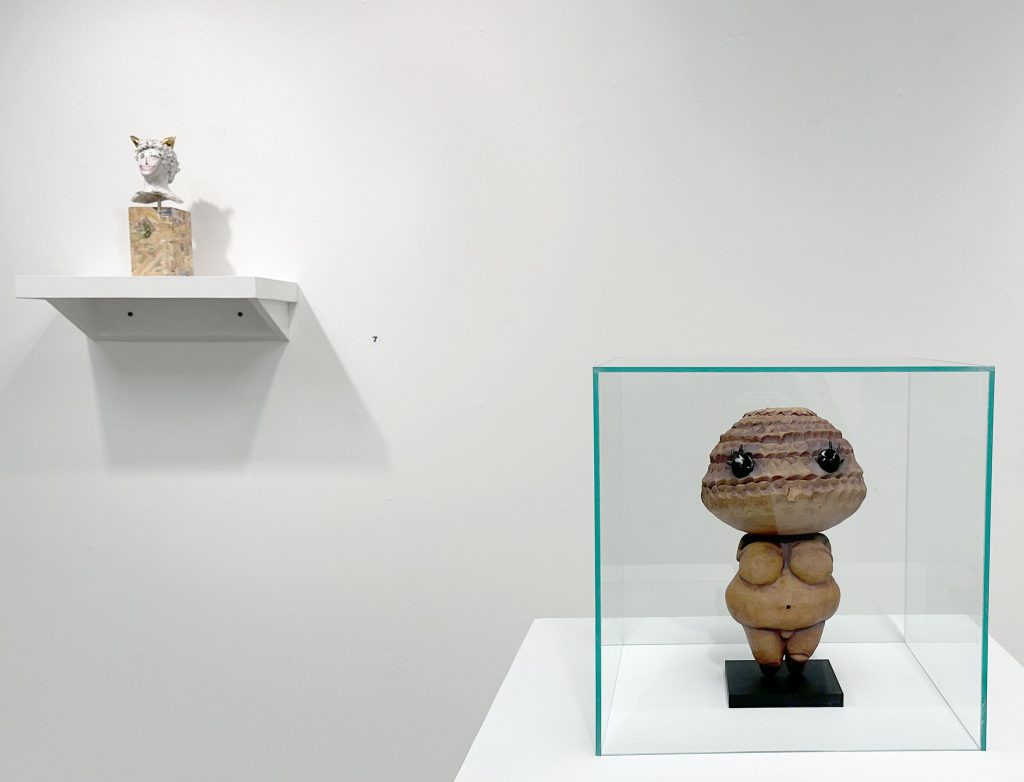
David Kruk’s solo exhibition Nobody Here at Summit Artspace in Akron, asks questions about the state of culture (or lack of culture) we are currently experiencing. Is the difference between the Venus of Willendorf and a Funko Pop just time period and material? Using the Vaporwave aesthetic, a remix of past pop culture in itself, he explores consumerism and nostalgia. Walking around the empty spaces in his video game creation, one is left wondering- what comes next?
The artist’s statement about the work-
This exhibition will consider Mark Fisher’s concept of “lost futures” through the aesthetics of Vaporwave and Funko Pops. I am interested in how these anachronistic objects utilize nostalgia through the remixing of cultural references to engage with consumer capitalism. According to Fisher, this continual referencing of the past exemplifies contemporary society’s cultural stagnation and the erosion of collective imagination towards a radically transformative future.
The sculptures in the exhibition are intended to push these anachronisms a bit further; to undergo a life cycle of adaptation and re-contextualization. I enjoy thinking about the ways in which something like Vaporwave can function as a critique of consumer culture, questioning capitalism’s impulse to commodify everything in sight, including our identities and memories. Vaporwave was born from the internet, and its aesthetic continues to be quite popular within online communities. These communities may often be collectors of pop culture paraphernalia: such as Funko Pops, which I’ve become interested in for their cultural symbolic value. Collecting Funko Pops can provide a source of aesthetic stability for some, while simultaneously operating as totems for coping with the realities of adulthood.
Conceptually within this exhibition, I wonder about the ideological trajectory from ritualistic idol to mass-produced fandom figurine, how capitalism influences our engagement with nostalgia, how the concept of a collectible operates within the spheres of the household to the museum, and how an art object may change over time through being digested through the body of consumerism.
For the video below, available on the gallery’s website, Kruk discusses his work – from tracing images using an oven light as a child, to a growing interest in sculpture, to creating the interactive video game from the show.
This exhibition closes 3/16/24.
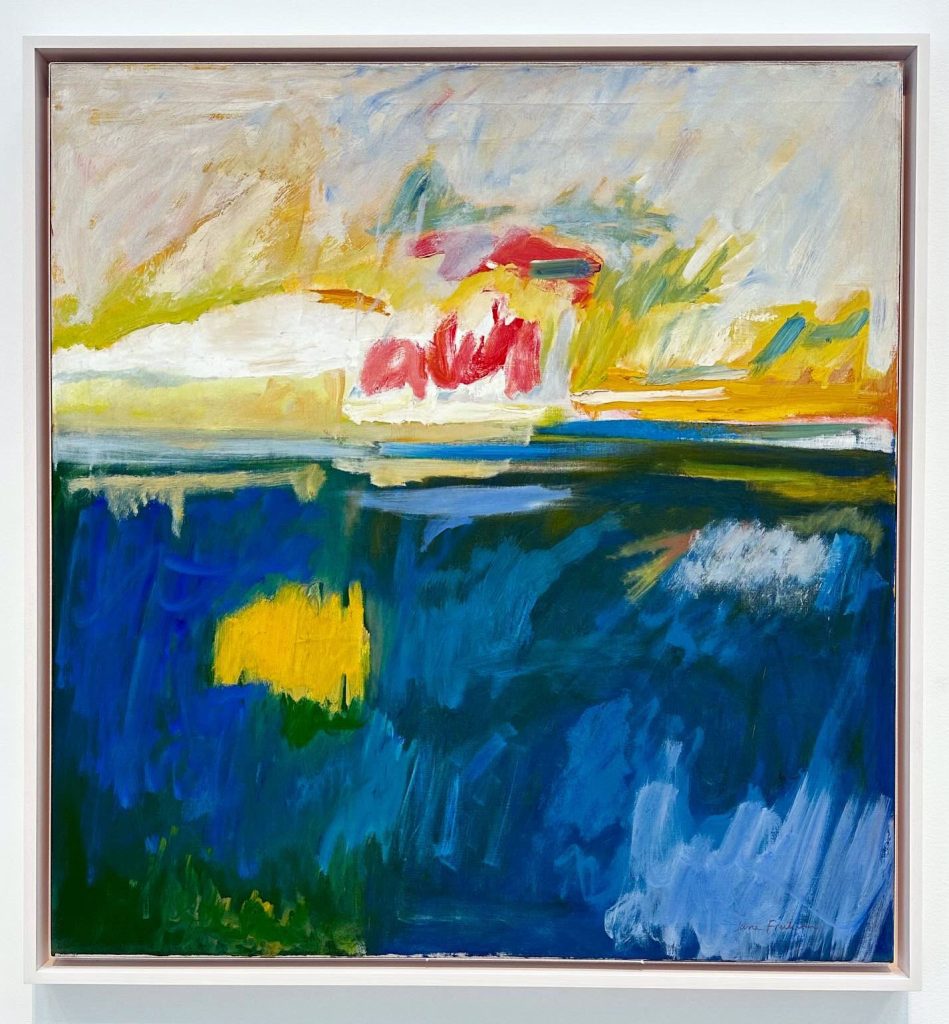
“Northern Lights”, 1959, oil on linen
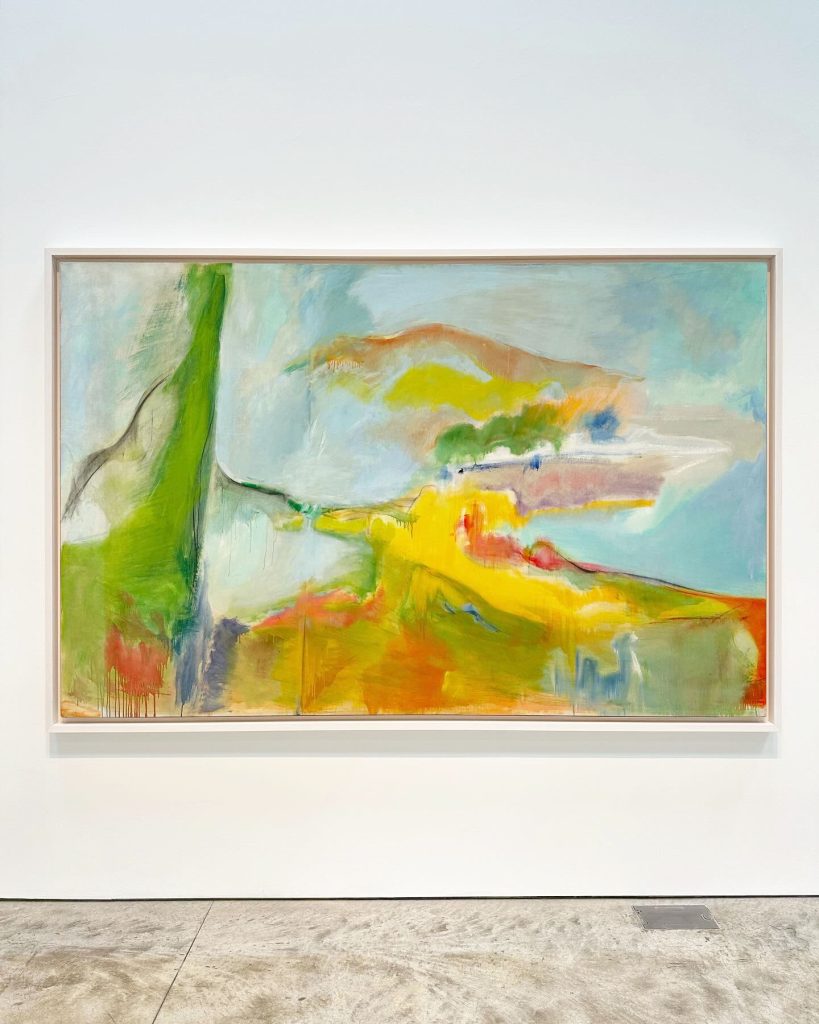
“Untitled (Near the Cove)”, c. 1958, oil on linen
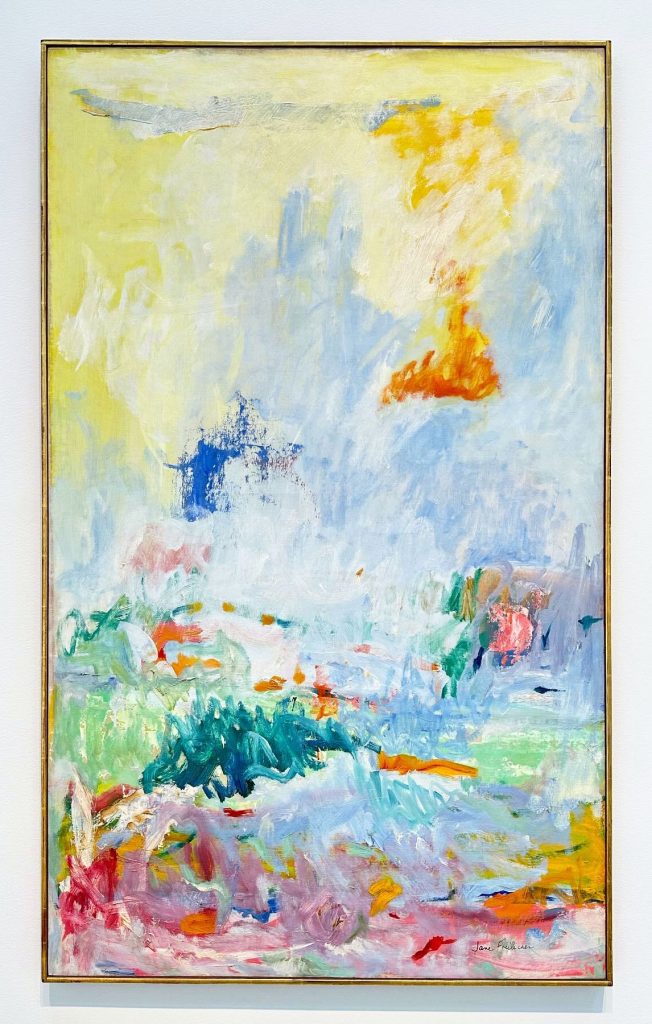
“Fresh Air”, c.1958-1962, oil on canvas
Although better known for her figurative paintings, Jane Freilicher also created several large abstract paintings which were on view last year at Kasmin gallery in NYC. The paintings hint at a recognizable landscape, but through her use of color and energetic brush strokes she evokes the feeling of being immersed in the beauty of nature- without the boundaries of a more realistic representation.
From the gallery about the work-
The exhibition presents a group of paintings in degrees of abstraction, realized by Freilicher between 1958 and 1962, a period of great inventiveness when the artist was spending stretches of time in Long Island but had yet to establish a studio there. The series marks a crucial moment of discovery and focus for Freilicher, who went on to integrate the freedom, fluidity, and confidence developed during this period into her more recognizable still lifes and landscapes of later decades.
Freilicher’s abstractions have their roots in observation, informed by her studies with legendary abstract painter Hans Hofmann at his schools in New York and Provincetown. In this group of paintings, pastoral landscapes from Water Mill, Long Island, are translated through the lens of the artist’s memory into confident gestural compositions defined by their use of color and sensitive depiction of light. In a 2006 interview for The New York Sun, the artist tells writer Jennifer Samet of this evolutionary moment in her practice: “I remember being overwhelmed by aqueous light and the obliteration of the horizon by fog.” Freilicher’s palette returns repeatedly here to a combination of off-white and light blue, rendered in loose brushwork across an expansive pictorial space to give a palpable impression of the airy, open landscape of the country.
Breaking out of the domestic scale necessitated by previous studio spaces, this generative period saw Freilicher regularly visiting Water Mill and then returning to her Manhattan studio where she would collapse the formal elements of the rural and coastal environments into energetic, improvisational paintings that were significantly larger than her earlier works. While approaching pure abstraction, the paintings from this period retain a compositional recognition of their ordering principles—the horizon line, a boat’s mast, the position of the sun in the sky, and, in the artist’s words, “long vistas of clouds and water.”
The metamorphosis of landscapes that figure prominently in the artist’s life are representative of, as Roberta Smith identified in 2006, “a more personal, grounded version of Color Field painting.” This observation bridges Freilicher to a loose group of contemporaries whose considerations of their immediate environments brought great warmth and aliveness to varying shades of abstraction—Milton Avery, Etel Adnan, Joan Mitchell, Agnes Martin, and Willem de Kooning (whose own abstract landscapes inspired by his time on Long Island went on view at Sidney Janis Gallery in 1959).
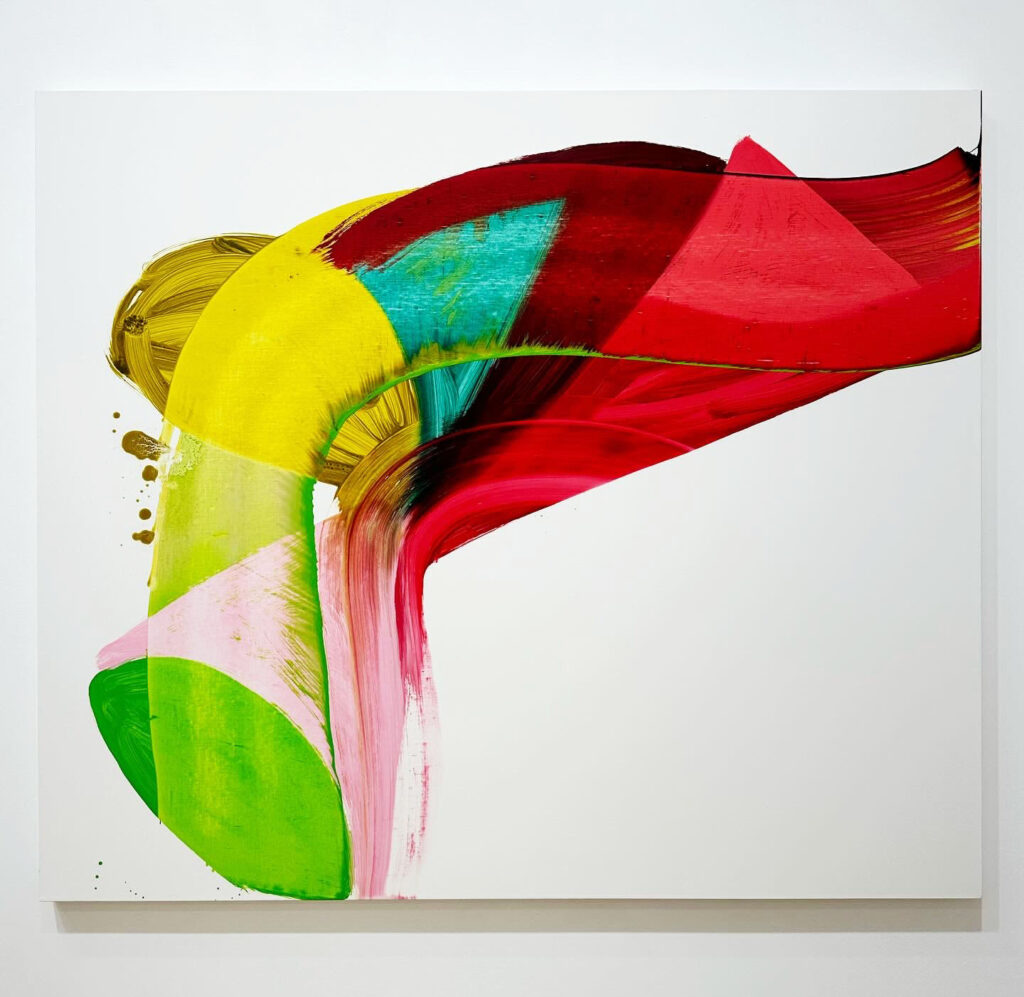
“Valentine”, 2022, oil on linen
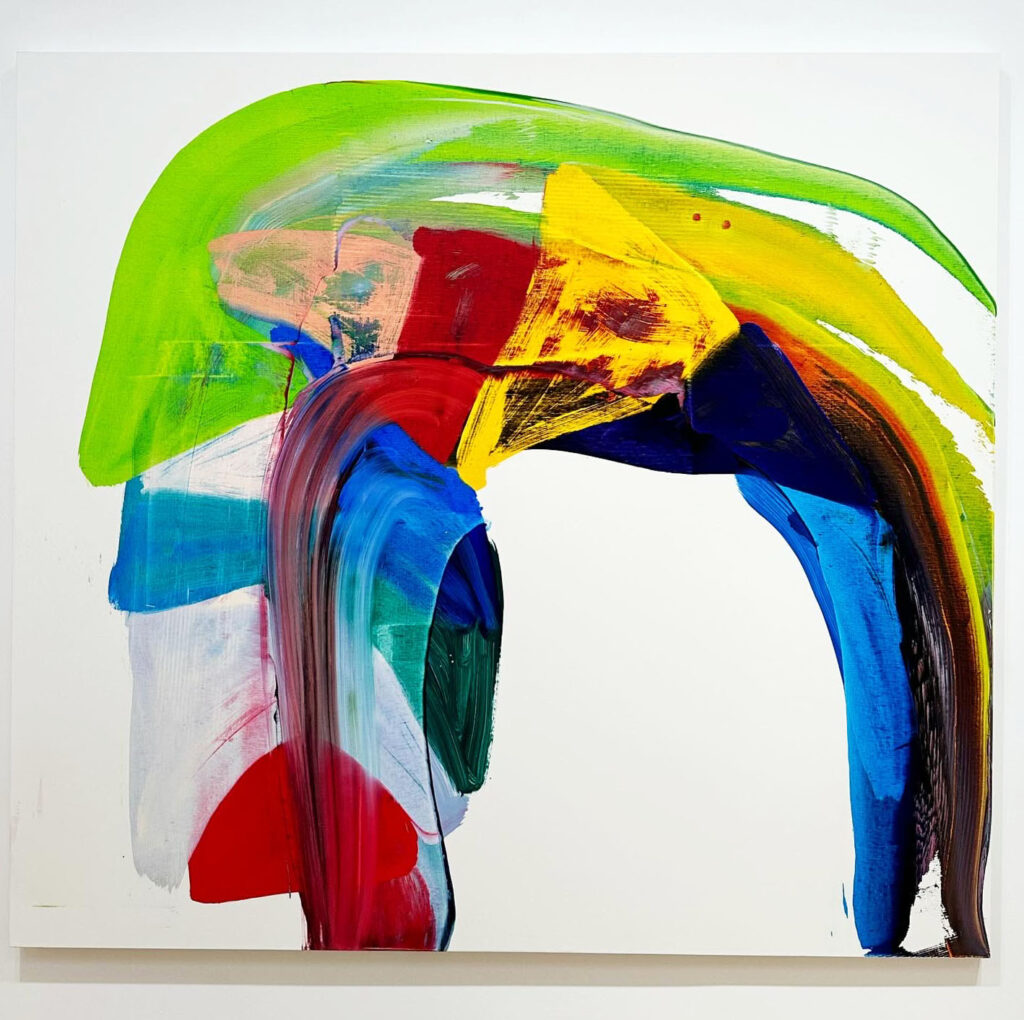
“Braid”, 2022, oil on linen
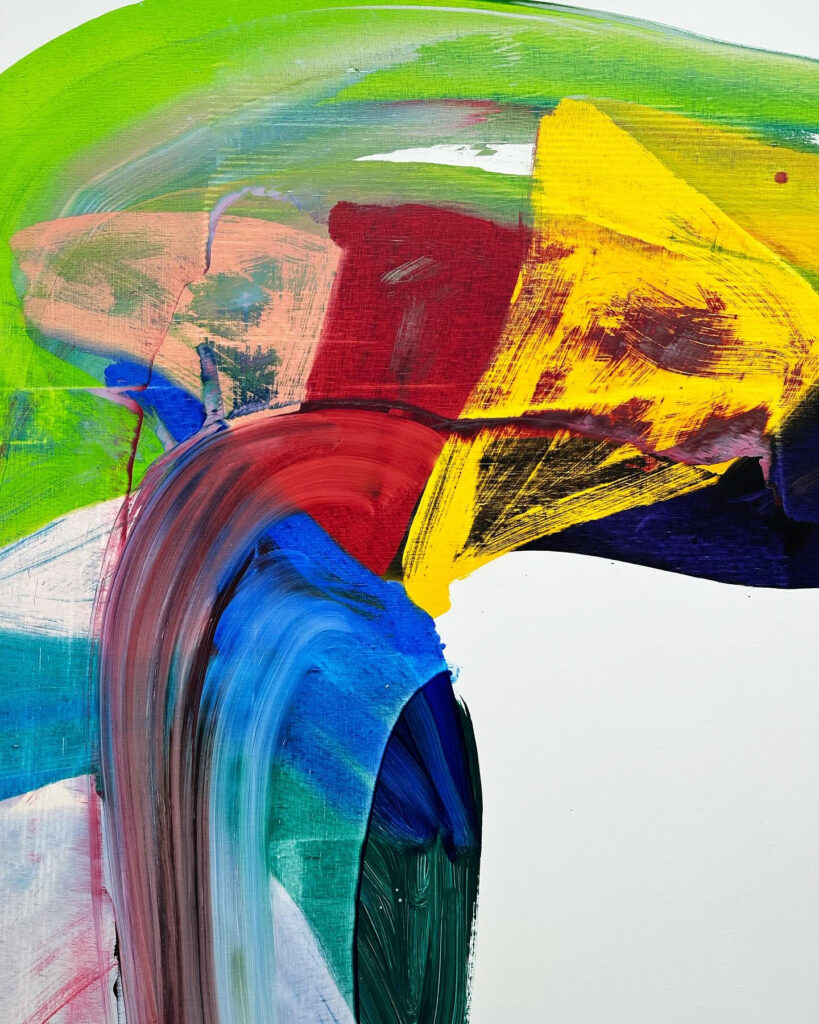
“Braid”, 2022, oil on linen (detail)
The two colorful paintings above are from Andrea Belag’s 2023 solo exhibition, Currents, at Bienvenu Steinberg & J in New York.
From the gallery’s press release-
Since the 1990s, Belag has constantly modified her approach to abstraction through various transitions and mutations. Her internal genealogy matters as much as her relationship to a tradition of abstraction. In the words of artist and critic Julian Kreimer: “it’s not hard to metaphorize those traces, lines left behind by larger swaths of paint that were wiped away, lines whose own shifting colors reveal how they are made by what they’ve touched and changed. But as with so many of Belag’s paintings, the point isn’t to nail down the metaphors (…) Belag’s work becomes an edge condition for painting without flirting with minimalist near-nothingness; it tests out where beauty can emerge, and what we can get to work. It opens up from a few wiped shapes into a sophisticated object able to transport one into a reverie about slippage, slipping away, the here and not hereness of life, death, and the varieties of love”.
Geometry and order have progressively given place to swirling swaths of color, solidity replaced by suspended motion. Painting is an all consuming action. She paints standing up, leaning over and often walking around the canvas placed horizontally. It starts with the arm and as she walks around the canvas her whole body gets involved. Transparent colors on the surface are not fixed and can create form or dissolve into light. She rubs, smudges, and scraps to create translucent, softly luminous surfaces where the brushwork is strikingly visible. “My paintings are contemporary because I paint in the here and now. It’s unavoidable. The artists I feel indebted to are Henri Matisse, Mary Heilmann, Joan Mitchell, Gerhard Richter, Bill Traylor, and Japanese Zen gardens. Style is a dead-end, but I have a point of view. I love transparency and the touch of materials, so I have created a way of painting where I make this possible. I use mostly transparent pigments and fine linen, and I paint wet into wet. The marks are on one layer of the painted surface with very little overlap or pentimento. Color makes space and light come through the paint and emotion comes through as well. There is fear and desire in painting, and that’s addictive. Haptics are the touchstones.” (Andrea Belag, 2023)
Her current solo exhibition, Twombly’s Green, opened this week at Steven Harvey Fine Art Projects.
From their press release-
This grouping of work is, as the title suggests, inspired by Belag’s recollection of Cy Twombly’s use of the color Hooker’s green in his “Pond Paintings.” She writes-
These paintings are inspired by my memory of Twombly’s green and white paintings that I first saw in the Menil Collection in Houston in 2015. I was stunned by his paint handling and his use of Hooker’s Green.
Since then, I learned he painted quickly and directly with his hands. Discovering the “Pond Paintings” was unexpected and I kept thinking about them. Hooker’s green is opaque and dark. But the dark value doesn’t overwhelm the hue. Instead, there is richness and depth without a trace of yellow.
When I identified the pigment and started to paint with it, I felt a vibration. There was a time when painting with green was taboo and now it is ubiquitous.
Is green in the zeitgeist?
All painted within the last twelve months, these works are a continuation of the artist’s practice of lush, energetic abstraction. Playing with circularity in an ongoing attempt to “get away from the grid,” Belag uses color as forms in space, bodies set in motion. Citing foundational inspirations in Matisse and Guston, who she later studied with at the New York Studio School, Belag’s work can also be related to vanguard practitioners of 80s abstraction such as Bill Jensen, David Reed and Mary Heilmann. Her immediate peers Christopher Wool and Joyce Pensato are also compass points in the stripped down dedication to raw painterly brio they share.
This exhibition is on view until 4/13/24.

Francesca Woodman, “Untitled (Rome), 1977-8, Gelatin silver print (image via Columbus Museum of Art)

Four Gelatin silver prints by Diane Arbus
Currently on view at Columbus Museum of Art is Arbus • Sherman • Woodman: American Photography from the 1960s and 1970s. Although many of these photographs by Diane Arbus, Cindy Sherman and Francesca Woodman are well known, it’s great to see the work of these three exceptional artists in person. The black and white images still captivate, even in our current image saturated world.
About the show from the museum-
This selection of monochromatic prints reflects a shared interest in capturing the world outside oneself as well as the world within. Perspective is an elemental link between each work: the images speak to how we see ourselves as individuals, how we are perceived, and how we observe others.
While Arbus was known for photographing families, children, pedestrians, performers, and celebrities, both Sherman and Woodman turned the camera on themselves. Dressing as anonymous female film characters from the 1950s and 1960s, Sherman poses in the series “Untitled Film Stills”. However, these works are not considered self-portraits, but rather carefully constructed performances of various female identities. Conversely, Woodman’s surrealist images might be called non-traditional self-portraits. By obscuring, blurring, or cropping parts of herself out of the final image, the photographs become intimate, personal snapshots that reflect a wider human fragility.
Arbus, Sherman, and Woodman are considered among the most prominent twentieth-century photographers and remain influential to contemporary artists today. By including aspects of feminism in their work and pushing the limits of the medium, these women challenged societal norms of their time while contributing to the elevation of photography as an art form.
It’s always interesting to hear artists discuss each other’s work. Included in the exhibition is this quote by Cindy Sherman about Francesca Woodman-
“She had few boundaries and made art out of nothing: empty rooms with peeling wallpaper and just her figure. No elaborate stage set-up or lights… Her process struck me more the way a painter works, making do with what’s right in front of her, rather than photographers like myself who need time to plan out what they’re going to do.”
For more on Francesca Woodman, her short life, and her artistic family, The Woodmans is an excellent documentary.